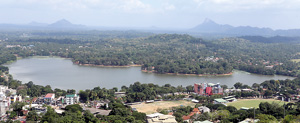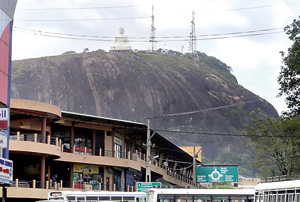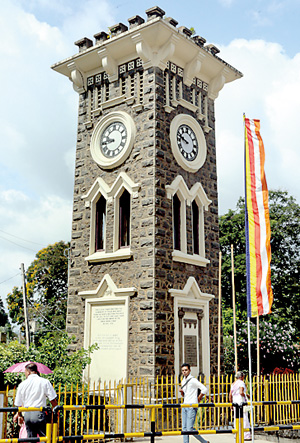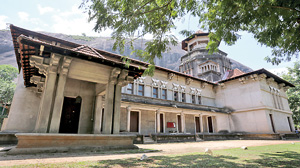Kurunegala, a regal city
 We have today, another Fun Travel piece – featuring this time, Kurunegala, an ancient kingdom of Sinhala Royalty. History states that the monarch changed its citadel to Dambadeniya, Yapahuwa and to Kurunegala from its
We have today, another Fun Travel piece – featuring this time, Kurunegala, an ancient kingdom of Sinhala Royalty. History states that the monarch changed its citadel to Dambadeniya, Yapahuwa and to Kurunegala from its
previous locations in Anuradhapura and Polonnaruwa due to pressure from foreign invasions.
Kurunegala, a distance of about 94 kilometres from Colombo is also known by the names Hasthisailapura and Athugalpura. The archaeological sites and ruins of importance apart, large rocks found in Kurunegala
are a distinct geographical feature of this regal city.
Athagala (Elephant Rock)
 The famous Athagala that resembles the shape of an elephant, lies 700 feet above ground level. On top of the rock is a 66 feet tall Buddha statue. Athagala can be reached through a flight of steps carved on the rock or via the 1.9 km motorable road that runs through Kachchriya Road. Atop the rock provides a panoramic view of the city and the surroundings.
The famous Athagala that resembles the shape of an elephant, lies 700 feet above ground level. On top of the rock is a 66 feet tall Buddha statue. Athagala can be reached through a flight of steps carved on the rock or via the 1.9 km motorable road that runs through Kachchriya Road. Atop the rock provides a panoramic view of the city and the surroundings.
Clock Tower

Kurunegala clock tower
The Clock Tower, found in the heart of Kurunegala town had been put up in memory of those who went from the North Western Province to World War I.
After the Second World War, it had been dedicated to the soldiers who
sacrificed their lives in World War II.
Yapahuwa Rock
Built around a huge granite rock, at a glance it resembles Sigiriya fortress. The location is a 30 km ride from Arankelle along Madagalla Road. It was believed that Yapahuwa served as a military stronghold for King Buwanekabahu I, to evade foreign invaders. Visitors to Yapahuwa rock can see many traces of the ancient palace and the fortress built by the king in 1273 – a steep stone stairway and the fortifications with moats and ramparts leads to the massive boulder and the famous Yapahuwa lion sculpture as guard stones on either side. This sculpture is featured on Sri Lanka’s 10 rupee note.
It is said that with the transfer of the kingdom from Dambadeniya to Yapahuwa, King Buwanekabahu brought the Sacred Tooth Relic to this location. Prior to King Buwanekabahu’s arrival there, a military leader by the name of Suba had occupied Yapahuwa rock as his military base to prevent Maga
invasions, and the place was therefore referred to as ‘Suba Pabbatha.’
Governor’s Office premises
Some ruins of archaeological value such as spouts, astragals, balustrades, stone door frames, stone pillars, guard stones and ruins of the Dalada Maligawa built in Kurunegala by King Parakramabahu IV can be found in the Kurunegala Governor’s Office compound.
Here you also find a wooden craft said to have been used by the royalty during Kurunegala era, excavated from the Kurunegala Lake later on.
Cathedral of Christ the King
 Along the Kurunegala – Kandy Road, you come across the Cathedral of Christ the King. The main Anglican Church of the Kurunegala Diocese, this was built in the 1950s by the
Along the Kurunegala – Kandy Road, you come across the Cathedral of Christ the King. The main Anglican Church of the Kurunegala Diocese, this was built in the 1950s by the
founder Bishop of the Kurunegala Diocese, Most Rev. Lakdasa de Mel, as the Diocese did not have a Cathedral back then. The nave, roof and the pinnacles of the church indicate that the structure is an amalgamation of Polonnaruwa and Kandy period architecture.
Rambodagalla Ridigama Temple
Acclaimed as the world’s largest granite Samadhi Buddha statue, Rambodagalla statue is carved on a rock boulder. The work of the statue initiated in September 2002, is still being carried out by a group of Indian sculptors with Padma Shri M. M. Sthapathi as its Chief Sculptor.
This 67.5-feet tall statue, a concept of Venerable Egodamulla Amaramoli Thero, came about following the destruction of Bamiyan Buddha statues by Taliban in 2001. Rambodagalla statue is a distance of about 20 km from the main town.
Arankelle Monastery
About 4 km interior from Kurunegala to Madagalla, through Ibbagamuwa you come across this reclusive monastery. During 800 – 1000 AD period, it had been
occupied by 12,000 monks in retreat from time to time. The monastery is spread across 65 acres of land. Back in the day it had all facilities needed for the monks in retreat, including medical care.
The ruins found today from the locations include; herbal grinders, hot baths with natural purification methods, stone
medicine strainers, sick rooms done out of massive rock slabs, the cave clusters used for meditation, ponds, urinals and a
1800 feet long walkway for monks. (Sakman Maluwa).
Ridi Viharaya
The temple lies close to Rambodagalla and it is believed that King Dutugamunu used the silver ore found from this location in building Ruwanwelisaya. A temple that dates back to King Dutugamunu’s era, Ridi Viharaya had developed with the influence of Anuradhapura, Polonnaruwa and Kandy periods.
The legendary story states that a group of merchants who came to the jungle close to the temple had offered some jack fruit to a Buddhist monk occupying a cave there. The monk Indraguptha, having consumed the jackfruit, had directed the merchants to a cave with a massive silver ore. It is the silver found from this
location that had been used to build Ruwanweliseya, and as a tribute, the king had constructed the temple. The structure where the monk Indraguptha accepted the jack fruit offered by the merchants known as Waraka Weladu Sthanaya (Place where Waraka was consumed) could be found at the temple. This stone pillar edifice, ornamented with elaborate carvings, resembles a Polonnaru era building.
The Sarasum Gala – a rock where King Dutugamunu dressed himself in royal attire is found to the right of the temple while atop the Sarasum Gala,
you find rock inscriptions.
An intricate carved ivory door frame found at the temple’s cave chamber, a gold Buddha statue brought to the temple by the king, marble statues of Lord Buddha, a statue of King Dutugamanu created out of Chandrakanthi stone provide an insight in to the historical era.
Inside the temple chamber, a set of tiles depicting the life of Jesus Christ is believed to have been donated by the then Dutch Governor to the priest back in the day. The upper temple chamber, rich with paintings that belong to the Kandyan period provides a wealth of knowledge for those with an interest on the art of temple paintings and murals.


